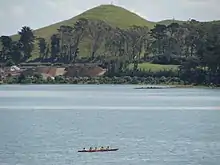Ihumātao
Ihumātao is a Māori village, situated three kilometres from Auckland International Airport in Mangere, Auckland (Tāmaki Makaurau) in New Zealand.
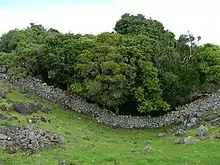
The New Zealand Ministry for Culture and Heritage gives a translation of "cold nose" for Ihumātao.[1] Māori first settled in the area as early as the 14th century CE. During the Invasion of the Waikato in 1863, the local Māori had their land confiscated by the New Zealand Government as punishment for supporting the Kingitanga movement. The land was largely used for farming until late 2016 when Fletcher Building acquired the site as part of a housing-development project. The Māori activist group "Save Our Unique Landscape" (SOUL) has opposed Fletchers' proposed housing development - SOUL has occupied the site and staged protests since 2016.[2][3][4]
In July 2019 SOUL were evicted from the site and eleven people were subsequently arrested, sparking a much larger occupation of several hundred people at Ihumātao that continues as of 2020. The dispute has been compared to the occupation of Bastion Point in the late 1970s (in which Māori protested against forced land-alienation by pākehā (European) settlers), including by activists who took part in the Bastion Point movement and who support SOUL's opposition to the housing development.[5] These events also sparked a series of protests around New Zealand, the scale of which has been compared to the protests against the 1981 Springbok Tour.[6]
Ihumātao stands on the Ihumātao Peninsula, in Mangere, at the base of the volcanic cone of Ōtuataua, part of the Auckland volcanic field.[7] The scoria cone reaches 64 metres (210 ft) (210 ft) above sea level and was the site of a large Māori pā (fortification).
History
Māori settlement
The Ōtuataua Stonefields are part of an area known as Ihumātao or Te Ihu a Mataoho ("The Nose of Mataoho"). The Stonefields feature Māori stone garden mounds and Māori and European dry-stone walls; the visible histories of Ihumātao are interwoven with the history of Auckland, as it is possible to trace the history of human presence in Auckland from initial Māori settlement to the arrival of Europeans in the 1860s with their pastoral farming techniques.[8][9]
.jpg.webp)
Ihumātao was first settled by Māori as early as the 14th century AD/CE.[10] According to traditions the first settlers were the Ngā Oho people. Their descendants became the Te Wai-o-Hua tribe.[11][12] The papakāinga (village) of Ihumātao is considered the oldest settlement in Auckland.[13]
The Ōtuataua Stonefields were part of a greater settlement of the Auckland Isthmus, which has been surveyed, mapped and investigated by archaeologists since the 1970s.[14][15][16] It is estimated that there was once about 8000 hectares of stonefield gardens, of which the 100 hectares at Ōtuataua is the last remaining example.[17] Other South Auckland stonefield garden sites included Wiri, where there were 300 hectares of prehistoric agricultural activity involving about 120 hectares of arable land growing kumara, taro and gourds,[16] and Matukutūreia (McLaughlins Mountain) which has been destroyed by quarrying.[16]
In the early 1980s a survey of South Auckland stone structures examined Ambury Park (Mangere Mountain), West Mangere (Ōtuataua), Wiri, McLaughlins Mountain (Matukutūreia), East Tamaki and Brown's Island (Motukorea).[18] The West Mangere area included Puketutu, Pukeiti, Ōtuataua and Maungataketake (Elletts Mountain). The assessment of the Ōtuataua stone fields was made from previous archaeological fieldwork and aerial photos as access to the land was not permitted at that time. The Pukeiti and Ōtuataua fields were possibly used due to their coastal location and compact size, however the coastal environment would prove difficult access and require excessive work due to the heavy mud deposits and shallow tide conditions. At Ōtuataua there were many different structure types and other evidence of settlement:[18]
- mounds of different shapes suggesting different cultigens and purposes
- walls and alignments indicating garden boundaries, planting bases and support for vines, and demarcation walls
- enclosures including demarcation of habitation areas. The size of enclosures ranged from 3M x 3M to 8M x 10M.
- middens
- stone facing on terraces
- fish traps[18]
The stonefield gardens show that the pre-European Māori had a sophisticated understanding of their environment by utilising the stones on the volcanic fields to build structures and walls and modifying that environment to nurture and grow crops which were not suited to a cooler climate.[17][18]
Crown acquisition and land contestation
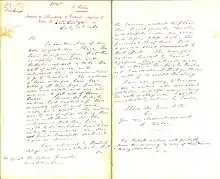
Tribal land was cleared in 1863, and then confiscated by Governor Grey in 1865 after local Māori supported the Māori King Movement (Kīngitanga) during the Waikato War. In 1867, the New Zealand Government acquired Ihumātao through a land grant. The land known as Oruarangi Block was farmed by the Wallace family for 150 years, who sold it to Fletcher Building in 2017 for a planned subdivision.[2][3][4][10]
The Manukau City Council attempted to preserve the land as part of the Ōtuataua Stonefields Historic Reserve in 2009, however this was later overruled on appeal by the Environment Court.[3] In 2014, the New Zealand Government and Auckland Council designated 32 hectares adjacent to the Ōtuataua Stonefields Historic Reserve as a Special Housing Area (SHA). This was met by opposition by a Māori activist group led by University of Auckland law graduate Pania Newton called "Save Our Unique Landscape" (SOUL), who opposed the proposed development due to Ihumātao's historical significance. SOUL staged protests and erected a whare and pou whenua on Ihumātao Quarry Road.[2][19]
In 2016, the "Wallace Block" on Ihumātao was sold to Fletcher Housing, a subsidiary of Fletcher Building, which has plans to build 480 houses on the land.[2][10] Archaeologist Dave Veart has described the planned Fletcher development as "like building houses on the fields alongside Stonehenge."[3] The Green Party announced its support for the preservation of Ihumātao in 2015.[20]
Protest action and occupation
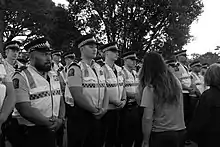
In response to Fletcher Building's planned housing development on the Oruarangi Bloc, the protest group SOUL led by Pania Newton set up camp beside Ihumātao Quarry Road on 4 November 2016. This camp, which became known as Kaitiaki Village,[21] numbered twenty individuals with participants sleeping in caravans, sheds, tents, and an empty boat. SOUL has contended that the land was taken by proclamation during the Waikato War in 1863 and that its confiscation under the New Zealand Settlements Act 1863 breaches the Treaty of Waitangi.[2][22][23][24]
In 2017, SOUL appealed to the United Nations, which recommended that the designation of Ihumātao as a Special Housing Area be reviewed by the Government to 'evaluate its conformity with the Treaty of Waitangi, the UN Declaration on the Rights of Indigenous Peoples and other relevant international standards' and that 'the free and informed consent of Māori is obtained before approving any project affecting the use and development of their traditional land and resources.'[25] In 2018, SOUL appealed to the Environment Court who declined to overturn the permission granted to Fletcher Building to build houses in Mangere.[2][26]
In March 2019, SOUL and their supporters in Wellington submitted a petition to the New Zealand Parliament demanding government intervention to prevent a confrontation on Ihumātao.[27] In April 2019, SOUL also delivered a 20,000 signature petition to the Mayor of Auckland Phil Goff, calling on the Auckland Council and Government to protect the land.[28]
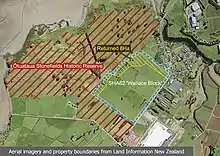
According to media reports, the Ihumatao housing development dispute is characterised by a generational divide within the local Māori iwi Te Kawerau ā Maki. While younger members of the tribe including Pania Newton and her cousins are opposed to the housing development and seek the return of Ihumātao to their iwi, tribal elders including Te Warena Taua support the housing development and regard Newton and her cousins' actions as disrespectful. The iwi's leadership body, the Te Kawerau Iwi Tribal Authority & Settlement Trust, have supported the housing development, stating that they had negotiated an agreement with Fletcher and Makaurau Marae Māori Trust for the land to be returned to "mana whenua {power associated with possession and occupation of tribal land}." Fletcher Housing has announced that they are committed to returning 25% of the land (roughly eight hectares) to the Kingitanga.[29][10]
On 23 July 2019, SOUL were served an eviction notice in the Oruarangi Block, and five people were subsequently arrested.[30] Another person was arrested after climbing on a vehicle to prevent it entering the blockaded area.[31] On 25 July Amnesty International sent human rights observers to the site to document the human rights situation and ensure the rights of protestors were respected.[32] Solidarity protests were held outside Parliament in Wellington on 24 July and Dunedin on 26 July.[18][33] Green Party co-leader Marama Davidson and MPs Chlöe Swarbrick and Golriz Ghahraman supported the protestors, but Prime Minister Jacinda Ardern said the Government would not intervene.[18]
On 25 July 2019, seven supporters of the occupation were arrested after blocking traffic on a road leading out of Auckland Airport to call attention to the situation at Ihumātao.[34]
Crown intervention and mediation
.jpg.webp)
On 26 July 2019, Prime Minister Ardern backtracked on her earlier announcement and announced that no further building would take place at Ihumātao while the Government and other parties negotiate a peaceful solution to the dispute.[35][36][10]
On 3 August 2019, Kīngi Tūheitia, the Māori King, visited Ihumātao with a contingent of over 400 and listened to mana whenua and supporters. Views and history were shared, and an account was given of Pōtatau Te Wherowhero, first leader of the Kīngitanga, receiving his title at Ihumātao. A Kīngitanga flag was also raised to fly until a resolution is reached.[37][38] Just hours after Tūheitia's visit, footage of two armed police officers carrying rifles around Ihumātao caused considerable alarm to protestors and supporters, and led to calls for guns to be removed from the site.[39]
On 4 August 2019, SOUL protestors and supporters held a hikoi to the maunga Puketapapakanga a Hape and back to the camp site through the fenced-off area of Kaitiaki Village, the site of SOUL's original occupation. At the same time, protestors pushed the police's frontline about 50 metres down Ihumātao Quarry Road from its original location at the intersection with Oruarangi Road, and moved tents into fields that had previously been blocked off by police.[40] As the hikoi passed through Kaitiaki Village, Organise Aotearoa members who had joined the occupation spoke with First Security workers hired by Fletcher Building, discovering – and later publicising – that for two weeks, the security guards, mostly recent migrants and students, had been sleeping in a milking station with broken windows on scavenged mattresses from Kaitiaki Village, where temperatures regularly drop below 5 degrees Celsius at night, without access to electricity, safe drinking water, or the meals they had been promised by First Security.[41]
On the night of 5 August 2019, there were reports of clashes between protesters and Police. Protesters accused the police of using kettling tactics and unreasonable force while Police claimed that protesters had attempted to breach the cordon around the disputed land. The next day, SOUL protesters and supporters staged a protest outside the Fletcher Building headquarters in Penrose in Auckland, as part of a national day of action that had been planned before the clashes of the previous night took place. Similar protests were held in Whangarei, Hamilton, Hastings, Palmerston North, Wellington, Christchurch, and Dunedin.[42][43][44][45][46]
In early August 2019, Opposition Leader Simon Bridges called on the protesters to "return home" and criticised Prime Minister Ardern for halting construction. Earlier, Mana Movement leader and Māori activist Hone Harawira denounced the police as "pigs" in a Facebook post. In response to Bridges' remarks, Ardern reiterated the Government's commitment to finding a solution to the Ihumātao dispute.[47][48] On 22 August, about 150 protesters marched from Ihumātao to Prime Minister Ardern's electorate office in Mount Albert calling on her to visit the site.[49][50] On the same day, a group of students including Youth MPs were expelled from Parliament for a year after disrupting parliamentary proceedings by singing the Māori song Tutira Mai Nga Iwi while holding up the Tino Rangatiratanga flag to draw attention to the hikoi.[51]
On 18 September 2019, the leader of the Kīngitanga Tūheitia Paki announced that mana whenua wanted the return of the land. He called on the Government to negotiate with Fletchers for the return of the land to its rightful owners.[52] The Māori Party also issued press release supporting the mana whenua of Ihumātao and calling on Prime Minister Ardern and the Crown to reach a solution with the mana whenua.[53] In response to media coverage, Deputy Prime Minister Winston Peters claimed that the SOUL protesters had little authority among the Māori community.[54] On 19 September, National MP Andrew Bayly was ejected from Parliament for attempting to disrupt Parliamentary proceedings by asking several questions about the implications of the Ihumātao dispute for treaty settlements nationally.[55] In mid September 2019, Acting Prime Minister Winston Peters stated that Finance Minister Grant Robertson had entered into meaningful discussions with Fletcher on how to deal with the disputed land.[56] In mid October, members of the SOUL group complained that they had been left out of talks between Fletcher and the Government.[57]
In early November 2019, the Crown heritage entity Heritage New Zealand announced that it was considering raising the heritage status of the Ōtuataua Stonefields reserve and the Ihumātao reserve to Category 1, the highest category ranking. Heritage NZ however stated that they would not change the consent for Fletcher Housing development.[58] In mid November, it was reported the Government was considering loaning the Auckland Council NZ$40 million to purchase the Ihumātao land from Fletcher Building. This announcement was met by criticism from elements of the Māori community, who reiterated their calls for the return of Ihumātao.[59][60] In late November 2019, Fletcher Housing chair Bruce Hassall defended the company's handling of the Ihumātao dispute, claiming that the company had bought the land in good faith, consulted with iwi groups, and followed proper land procedures.[61]
On 21 January 2020, Pania Newton, the leader of the SOUL group, issued a statement to the media that they were close to completing a deal on the disputed land at Ihumātao. Fletcher Building also stated that discussions on the future of the site were "progressing." Fletcher also removed fencing and restored a road to the maunga.[62][63] On 23 June, Radio New Zealand reported that the Government was considering making a decision to purchase Ihumātao under the Housing Act.[64]
On 17 December 2020, the Government reached a deal with Fletcher Building to buy the disputed Ihumātao land for NZ$30 million with the proposal that it be used for housing purposes. A steering committee consisting of the ahi kā (the occupiers), a Kīngitanga representative, and two representatives of the Crown would decide its use, with the Auckland Council acting in an observer role.[65][66]

Ōtuataua

The volcanic cone of Ōtuataua is sited within the Ōtuataua Stonefields Historic Reserve and as the dominant landscape feature, lends the 100 hectare reserve its name. The cone provided a fortified village to the original inhabitants, with the lower slopes of the volcano supporting intensive Māori gardening. The volcanic soils extend all the way to the shoreline where there was access to the abundance of the Manukau Harbour. The sandy beaches and wide tidal flats were once rich with shellfish and the harbour provided fish and a regionally important shark fishery.[67][10]
The Ōtuataua cone was quarried in the 1950s, and the scoria used for building work – including the building of Auckland Airport. At the completion of quarrying, remedial reconstruction created a shallow, grassy crater.
Adjacent to Ōtuataua in the Ōtuataua Stonefields Historic Reserve lies Pukeiti (literally "small hill"), Auckland's smallest volcano.
References
- "1000 Māori place names". New Zealand Ministry for Culture and Heritage. 6 August 2019.
- Haunui-Thompson, Shannon (24 July 2019). "Explainer: Why Ihumātao is being occupied by 'protectors'". Radio New Zealand. Retrieved 26 July 2019.
- Chapple, Geoff (3 June 2016). "Ihumātao and the Ōtuataua Stonefields: A very special area". New Zealand Listener; Noted. Retrieved 26 July 2019.
- "Ihumātao eviction: Planned Auckland development reignites anger of the land wars". Stuff.co.nz. Retrieved 24 July 2019.
- "Bastion Point's Joe Hawke supports fight for Ihumatao in south Auckland". RNZ. 1 December 2016. Retrieved 15 August 2019.
- Compare: "Q+A: Ihumātao: Can protests really change things?". The University of Auckland. 2 August 2019. Retrieved 15 August 2019.
[T]he protesters themselves would claim substantial change was bought about through what they did. You can certainly look at Bastion Point as an example of a very successful protest, one carried out entirely on principles of natural justice, it wasn't designed to necessarily attack other people or some other political motive, it was entirely based on the fact that the protesters knew that what they were doing was right. The same with Springbok tour protesters: those who opposed the tour felt that what they were doing was right and I know some of them have claimed some credit for bringing down the Apartheid system in South Africa. Whether or not that is absolutely true we will never know but certainly some protesters feel that what they do does effect change.
- "Ōtuataua Stonefields". Auckland Council. Retrieved 7 December 2015.
- "Ōtuataua Stonefields | NZHistory, New Zealand history online". NZHistory. Ministry for Culture and Heritage. Retrieved 26 July 2019.
- Fernandes, Kymberlee (8 December 2016). "Report: rock walls prove 'historic Maori farming' practices". Stuff.co.nz. Retrieved 26 July 2019.
- Russell, Alexia (30 July 2019). "The Detail: Why Ihumātao has opened up rifts among Māori". Stuff.co.nz. Retrieved 30 July 2019.
- "Otuataua Stonefields Historic Reserve" (PDF). Auckland council. Retrieved 30 July 2019.
- Taonui, Rāwiri (22 March 2017). "Tāmaki tribes – The tribes of Tāmaki". Te Ara – the Encyclopedia of New Zealand. Retrieved 30 July 2019.
- "Ihumatao – past and present". Science Learning Hub. Retrieved 24 July 2019.
- Sullivan, Agnes (1972). "Stone walled complexes of central Auckland". New Zealand Archaeological Association Newsletter. 15 (4): 148–160.
- Sullivan, Agnes (1974). "Scoria mounds at Wiri". New Zealand Archaeological Association Newsletter. 17 (3): 128–143.
- Lawlor, Ian (1981). Puhinui (N42/17) excavation report. Auckland: University of Auckland. OCLC 151810399.
- Farley, Glen (2014). Archaeological investigations at Timberly Road, Mangere: final report (PDF). Auckland: Clough and Associates. pp. 8–9. OCLC 993615594.
- Rickard, Vivien; Veart, David; Bulmer, Susan (1984). A review of archaeological stone structures of South Auckland. Auckland: NZ Historic Places Trust. pp. 27, 28, 46–49, 50, 56. OCLC 948024954.
- "Conversations: Pania Newton". E-Tangata. 5 March 2019. Retrieved 26 July 2019.
- "Ihumatao should be protected". Green Party of Aotearoa New Zealand. 28 August 2015. Retrieved 24 July 2019.
- Hayden, Leonie (September 2017). "When worlds collide". No. 147. New Zealand Geographic. Cite magazine requires
|magazine=(help) - Lawton, Nicole. "A Time and a Place: Ōtuataua Stonefields Historic Reserve peaceful occupation". Stuff.co.nz. Retrieved 14 March 2017.
- "Tent embassy erected to prevent Ihumātao development". Māori Television. Retrieved 14 March 2017.
- "'A wonderful new neighbourhood': Fletcher Residential buys 'sacred' Maori land at Ihumatao in south Auckland". Stuff.co.nz. Retrieved 24 July 2019.
- Gibson, Anne (31 August 2017). "UN committee: concerns around consultation on Ihumatao". New Zealand Herald. ISSN 1170-0777. Retrieved 24 July 2019.
- Theunissen, Matthew (8 November 2018). "Decision allows development near sacred Māori site". Radio New Zealand. Retrieved 26 July 2019.
- Fernandes, Kymberlee (12 March 2019). "South Auckland group takes land protest to Parliament". Radio New Zealand. Retrieved 26 July 2019.
- Huffadine, Leith (10 April 2019). "Hikoi confronts Phil Goff over Ihumātao development". Radio New Zealand. Retrieved 26 July 2019.
- Johnsen, Meriana (25 July 2019). "Ihumātao protest: Kaumātua and rangatahi split over development". Radio New Zealand. Retrieved 26 July 2019.
- "Ihumātao eviction live: Dogs pepper sprayed, protesters arrested". Stuff. Retrieved 24 July 2019.
- "Battle for Ihumātao: Another arrest as protesters lose faith in police". RNZ. 24 July 2019. Retrieved 24 July 2019.
- "Ihumātao stand-off: Protesters try to block main road to airport". RNZ. 25 July 2019. Retrieved 11 August 2019.
- "Dunedin protest held to support Ihumatao dispute". Otago Daily Times. 26 July 2019. Retrieved 26 July 2019.
- "Protecting Not Protesting - Seven Arrested". Scoop. 25 July 2019. Retrieved 15 August 2019.
- "Ihumātao protests: No building while a solution is sought – PM". Radio New Zealand. 26 July 2019. Retrieved 26 July 2019.
- "PM blocks building at Ihumatao". Otago Daily Times. 26 July 2019. Retrieved 26 July 2019.
- Dunlop, Māni (3 August 2019). "Ihumātao: Protesters accept Kiingitanga's offer to host hui". Radio New Zealand. Retrieved 11 August 2019.
- "Kīngitanga flag raised at Ihumātao, to stay until resolution reached". New Zealand Herald. 3 August 2019. Retrieved 11 August 2019.
- "Calls for police to remove guns from Ihumātao after rifle sighting". Te Ao: Māori News. 4 August 2019. Retrieved 20 August 2019.
- Bond, Jordan (5 August 2019). "Ihumātao protesters move past frontline: 'We're in for the long haul'". Radio New Zealand. Retrieved 15 August 2019.
- "Security workers at Ihumaatao denied meals". Organise Aotearoa. Scoop. 5 August 2019. Retrieved 15 August 2019.
- "Police 'rammed' Ihumatao protesters: Organiser". Otago Daily Times. 6 August 2019. Retrieved 6 August 2019.
- "Ihumātao police presence 'very intimidating' – protest leader Pania Newton". Radio New Zealand. 6 August 2019. Retrieved 6 August 2019.
- Daly, Michael; Rosenberg, Matthew (6 August 2019). "Ihumātao: Police deny pushing protester to ground". Stuff.co.nz. Retrieved 6 August 2019.
- "Police release statement regarding Ihumatao protest". Fuseworks Media. Voxy.co.nz. 6 August 2019. Retrieved 6 August 2019.
- "Ihumātao: Today's Nationwide Day of Action". The Standard. 6 August 2019. Retrieved 14 August 2019.
- O'Driscoll, Edward (11 August 2019). "'Go home': Simon Bridges' message to Ihumātao protesters". Newshub. Retrieved 15 August 2019.
- "Prime Minister should tell Ihumātao protesters to go home - Simon Bridges". Radio New Zealand. 11 August 2019. Retrieved 15 August 2019.
- "Ihumatao: Hikoi begins to PM's office". Otago Daily Times. 22 August 2019. Retrieved 24 August 2019.
- Anderson, Charles (22 August 2019). "Hundreds of protesters march on Jacinda Ardern's office over Māori land dispute". The Guardian. Retrieved 24 August 2019.
- McCullough, Yvette (22 August 2019). "Protesters banned from Parliament for singing despite warning". Radio New Zealand. Retrieved 24 August 2019.
- McLachlan, Leigh-Marama (18 September 2019). "Mana whenua reach decision on Ihumātao land". Radio New Zealand. Scoop. Retrieved 19 September 2019.
- "Mana whenua reach decision on Ihumātao land". Māori Party. Scoop. 18 September 2019. Retrieved 19 September 2019.
- "Winston Peters appalled over Ihumātao coverage". Newstalk ZB. 19 September 2019. Retrieved 19 September 2019.
- Small, Zane (19 September 2019). "National MP Andrew Bayly booted from Parliament over Ihumātao questioning". Newshub. Retrieved 20 September 2019.
- "Ihumātao: Govt had 'meaningful' discussions with Fletchers". Radio New Zealand. 23 September 2019. Retrieved 21 January 2020.
- Hurihanganui, Te Aniwa; Johnsen, Meriana (17 October 2019). "Ihumātao protesters shut out of government talks". Radio New Zealand. Retrieved 21 January 2020.
- Johnsen, Meriana (5 November 2019). "Occupied Ihumātao land could be granted highest heritage status". Radio New Zealand. Retrieved 21 January 2020.
- Moir, Jo (19 November 2020). "Ihumātao: Crown considers loan for Auckland Council to buy land". Radio New Zealand. Retrieved 21 January 2020.
- McLachlan, Leigh-Marama (20 November 2019). "Ihumātao: Mana whenua disappointed over talk of $40m loan to council". Radio New Zealand. Retrieved 21 January 2020.
- "Fletcher chair makes first substantive comments on Ihumātao". Radio New Zealand. 28 November 2019. Retrieved 21 January 2020.
- "Fletcher Building takes down fences at Ihumātao". Radio New Zealand. 21 January 2020. Retrieved 21 January 2020.
- Neilson, Michael (21 January 2020). "'We are really relieved': Deal on Ihumātao 'hours away' Pania Newton says". New Zealand Herald. Retrieved 21 January 2020.
- "Ihumātao might be acquired under Housing Act". Radio New Zealand. 23 June 2020. Archived from the original on 23 June 2020. Retrieved 23 June 2020.
- Patterson, Jane (17 December 2020). "Ihumātao: Deal struck between government and Fletcher Building to buy disputed land". Radio New Zealand. Archived from the original on 17 December 2020. Retrieved 17 December 2020.
- "Government to buy disputed land at Ihumātao for close to $30 million". 1 News. 17 December 2020. Archived from the original on 17 December 2020. Retrieved 17 December 2020.
- Blithe, Rebecca. "Gateway to Auckland". The Aucklander – New Zealand Herald. Retrieved 26 July 2019.
